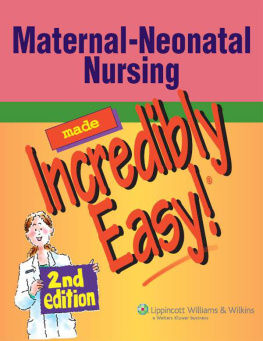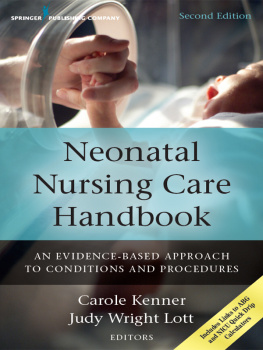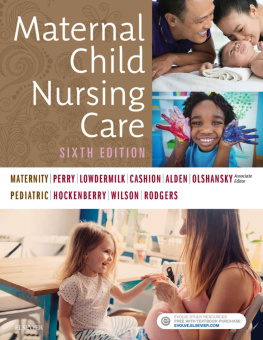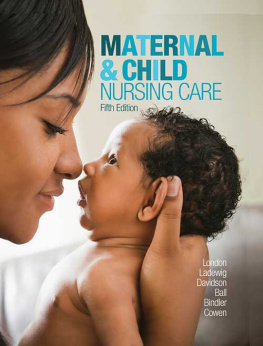Judith A. Schilling McCann, RN, MSN
Joan M. Robinson, RN, MSN
Tracy S. Diehl
Laura Bruck, Karen C. Comerford
Beth J. Welsh
Karen J. Kirk, Linda K. Ruhf, Jeri OShea
The clinical treatments described and recommended in this publication are based on research and consultation with nursing, medical, and legal authorities. To the best of our knowledge, these procedures reflect currently accepted practice. Nevertheless, they cant be considered absolute and universal recommendations. For individual applications, all recommendations must be considered in light of the patients clinical condition and, before administration of new or infrequently used drugs, in light of the latest package-insert information. The authors and publisher disclaim any responsibility for any adverse effects resulting from the suggested procedures, from any undetected errors, or from the readers misunderstanding of the text.
p. ; cm.
Includes bibliographical references and index.
1. Maternity nursing. 2. Neonatology. I. Lippincott Williams & Wilkins.
[DNLM: 1. Maternal-Child Nursing. WY 157.3 M42555
2008]
ISBN-13: 978-1-58255-651-2 (alk. paper)
ISBN-10: 1-58255-651-2 (alk. paper) 2007025528
Contributors and consultants
Christine C. Askham, RN, BSN
VN Faculty
Unitek College
Fremont, Calif.
Kimberly Attwood, RN, PhD(c)
Instructor
DeSales University
Center Valley, Pa.
Beatrice Beth Benda, RNC, MSN
Staff Nurse
Allina Hospitals & Clinics
University of Minnesota Fairview Riverside Maternal Fetal Medicine Clinic
Minneapolis
Anita Carroll, EdD, MSN
Nursing Instructor
West Texas A&M University
Canyon
Marsha L. Conroy, RN, MSN, APN
Nursing Instructor
Cuyahoga Community College
Cleveland
Kim Cooper, RN, MSN
Nursing Department Program Chair
Ivy Tech Community College of Indiana
Terre Haute
Patti F. Gardner, MSN, CNM, IBCLC
Clinical Nurse Specialist: Womens Health & Lactation
United Medical Center
Cheyenne, Wyo.
Valera A. Hascup, RNC, MSN, PhD (c), CCES, CTN
Assistant Professor of Nursing and Director of the Transcultural Nursing Institute
Kean University
Union, N.J.
Vivian Haughton, RN, MSN, CCE, IBCLC
Clinical Nurse SpecialistMaternal/Child Health
Good Samaritan Health System
Lebanon, Pa.
Dana M. L. Hinds, RN, MSN, FNP
Nursing Instructor, Family Nurse Practitioner
Central Maine Medical Center School of Nursing
Lewiston
Beverly Kass, RNC, MS
Faculty
William Paterson University
Wayne, N.J.
Randy S. Miller, RN-C, BS, MSN
Student Coordinator
Orlando (Fla.) Regional Healthcare
James F. Murphy, RNC, MS
Educator/Instructor
ViaHealth/Rochester General Hospital
Isabella Graham Hart School of Nursing
Rochester, N.Y.
Noel C. Piano, RN, MS
Instructor/Coordinator
Lafayette School of Practical Nursing
Adjunct Faculty
Thomas Nelson Community College
Williamsburg, Va.
Janet Somlyay, RN, MSN, CNS, CPNP
Clinical Nurse SpecialistPediatrics and Nursery
United Medical Center
Cheyenne, Wyo.
Robin R. Wilkerson, RN, PHD
Associate Professor of Nursing
University of Mississippi
Jackson
Foreword
Nursing educators have long been tasked with making important nursing content stick in the minds of students and nurses. For this reason, we often find ourselves asking what it takes for nursing concepts, facts, and research findings to embed themselves in the brain, resulting in well-reasoned utilization of nursing processes and knowledgeable critical thinking. A couple of answers come to mind.
First, learning more readily occurs if theres a catalyst to assist it. Educators now realize that by encouraging students active involvement in the learning process and using various adult learning methodologies, we can facilitate knowledge acquisition and application. Some of these methods include various forms of testing, case scenarios, and simulations.
Second, any way in which the educator can combine a fun experience with the learning process is a positive one. These experiences can come in the form of cartoons, funny poems, puzzles, contests, jokes, humorous or clever analogies, or even songs. There are no limits to the methods.
As a nursing educator, Im drawn to resources that blend the elements of active learning and fun. This combination is what attracted me to the second edition of Maternal-Neonatal Nursing Made Incredibly Easy.
Those familiar with the first edition will be pleased to encounter the same well-loved features that helped make it an excellent resource. Comprehensive information is still conveyed succinctly in multiple forms that actively engage the reader. Original content has been updated and enhanced with tables, charts, diagrams, illustrations, quizzes, and delightful cartoons that help the reader focus on key facts. Additional content areas include information on grief and loss, bed rest, postpartum depression, alternative therapies, and substance abuse.
Some exciting additions include a CD with more than 300 NCLEX-style questions, including alternate-format questions. The CD also contains a list of nursing diagnoses by disorder, covering all of the disorders featured in the text. Concept maps for some nursing problems are also included.
In addition, icons draw your attention to important issues:
 Advice from the experts tips and tricks for maternal-neonatal nurses from the people who know bestother maternal-neonatal nurses.
Advice from the experts tips and tricks for maternal-neonatal nurses from the people who know bestother maternal-neonatal nurses.
 Education edge patient-teaching tips and checklists that help the nurse pass along information that can be vital to promoting a healthy pregnancy and preventing complications.
Education edge patient-teaching tips and checklists that help the nurse pass along information that can be vital to promoting a healthy pregnancy and preventing complications.








 Advice from the experts tips and tricks for maternal-neonatal nurses from the people who know bestother maternal-neonatal nurses.
Advice from the experts tips and tricks for maternal-neonatal nurses from the people who know bestother maternal-neonatal nurses. Education edge patient-teaching tips and checklists that help the nurse pass along information that can be vital to promoting a healthy pregnancy and preventing complications.
Education edge patient-teaching tips and checklists that help the nurse pass along information that can be vital to promoting a healthy pregnancy and preventing complications.